Index: History | Nutritional health values | Worldwide cultivation of strawberries | Plant description and physiology | Fruit types | Strawberry cultivars
1.1 History
The first documented botanical illustration of a strawberry plant appeared as a figure in herbaries in 1454.
Strawberries were probably first grown in gardens in the 13th or 14th centuries, but for many years afterwards, especially in England, they differed little from the wild plants.
The American Indians were already eating strawberries when the colonists arrived. The crushed berries were mixed with cornmeal and baked into strawberry bread. After trying this bread, colonists developed their own version of the recipe and strawberry shortcake was created.
The English "strawberry" comes from the Anglo-Saxon "streoberie" not spelled in the modern fashion until 1538. The name strawberry probably comes from ‘strayberry’, for the runners cause young plants to stray from the parent.
All attempts to breed and improve the strawberry crop from European cultivars of the species Fragaria vesca failed until American varieties belonging to the species F. virginiana and F. Chiloensis were introduced to Europe in the 17th century. In 1780, the first strawberry hybrid "Hudson" was developed in the United States.
Almost all current commercial varieties worldwide belong to the species Fragaria x ananassa Duch., and are octaploid (8n) in their genetic makeup, containing 56 chromosomes. This voluminous makeup gives the crop its high diversity and excellent potential to grow well and express its performance in a large variety of growth conditions, from (irrigated) deserts like South California and North Africa, through equatorial conditions as in Latin America and Central Africa, up to Alpine conditions in Scandinavia, Canada and Alaska.
Fragaria x ananassa, with large fruit (10 to 40 g), is by far the most important cultivated species, but other types of wild European strawberry are:
-
The small-fruited Alpine strawberry, a form of Fragaria vesca. It is especially valuable as it has a much longer fruiting season and better flavored fruits.
-
Fragaria chiloensis are also cultivated.
1.2 Nutritional and health values of the strawberry fruit
Table 1.1: The nutritive value of a serving (147 g) of edible strawberries.Source: US Food and Drug Administration, 2009
|
Energy
|
45 cal
|
Vitamin A
|
45 IU
|
|
Protein
|
1.0 g
|
Vitamin C
|
94 mg
|
|
Fat
|
0.0 g
|
Niacin (Vitamin B3)
|
540 mcg
|
|
Carbohydrate
|
11 g
|
Folate
|
29.38 mcg
|
|
Dietary fiber
|
2.0 g
|
Manganese
|
540 mcg
|
|
Calcium
|
23.2 mg
|
Iron
|
0.6 mg
|
|
Magnesium
|
16.6 mg
|
Selenium
|
1.16 mg
|
|
Potassium
|
170 mg
|
Zinc
|
0.2 mg
|
|
Phosphorous
|
31.5 mg
|
Sodium
|
0 mg
|
The strawberry’s high levels of potassium and magnesium help regulate blood pressure and help promote nutrient functions. The magnesium content also relaxes nerves and muscles and keeps blood circulating smoothly. Strawberries are richer in Vitamin C than citrus fruits. The very high content of Vitamin C supplies ~160% of the daily requirement (%DV) in one serving (147 g) of this fruit!
Strawberries are rich in niacin, belonging to the B-vitamin group. Niacin deficiency causes the pellagra disease. Niacin has been used for over 50 years to increase levels of HDL in the blood and has been found to modestly decrease the risk of cardiovascular events in humans.
Usage forms
Strawberries are marketed fresh and frozen. They are also processed for preserves, flavoring, concentrates and extracts.
1.3 Worldwide cultivation of strawberries
Table 1.2: Countries with the largest strawberry cultivation areas, down to 3,000 ha.
Source: FAO, 2012
|
Countries with over 3,000 ha
of strawberry cultivation
|
Ha
|
Yield
(MT / ha)
|
|
Poland
|
51,730
|
3.4
|
|
Russian Federation
|
26,000
|
6.3
|
|
USA
|
23,060
|
26.1
|
|
Germany
|
13,644
|
11.5
|
|
Turkey
|
11,679
|
25.7
|
|
Ukraine
|
8,100
|
7.1
|
|
Belarus
|
8,000
|
6.9
|
|
Serbia
|
7,603
|
4.3
|
|
Spain
|
7,000
|
39.3
|
|
Republic of Korea
|
6,500
|
35.7
|
|
Mexico
|
6,282
|
36.1
|
|
Japan
|
6,000
|
29.6
|
|
Italy
|
5,990
|
25.7
|
|
Egypt
|
5,245
|
45.5
|
|
United Kingdom
|
4,968
|
20.7
|
|
Finland
|
3,311
|
3.1
|
|
Canada
|
3,042
|
6.4
|
|
Morocco
|
3,035
|
46.3
|
|
World total
|
243,907
|
17.9
|
In several countries, for instance in Poland, which holds the world's record for largest growth hectarage, a large proportion of the crop is processed.
As seen above, most hectarage of strawberry production is concentrated in the northern hemisphere, but there is no agronomic reason to avoid increasing the growth areas in the southern hemisphere as well. Africa and Latin America are natural candidates for this expansion.
Table 1.3: Countries with the highest strawberry yield areas, down to the world mean figure. Source: FAO, 2012
|
Countries with strawberry yields over 20 MT / ha
|
Strawberry yield (MT / ha) in the country
|
Strawberry hectares in the country
|
|
Cyprus
|
57.5
|
32
|
|
USA
|
56.1
|
23,060
|
|
Kuwait
|
48.0
|
10
|
|
Morocco
|
46.3
|
3,035
|
|
Egypt
|
45.5
|
5,245
|
|
Spain
|
39.3
|
7,000
|
|
Israel
|
36.3
|
610
|
|
Mexico
|
36.1
|
6,282
|
|
Republic of Korea
|
35.7
|
6,500
|
|
Colombia
|
30.2
|
1,567
|
|
Belgium
|
29.7
|
1,100
|
|
Japan
|
29.6
|
6,000
|
|
Costa Rica
|
27.7
|
168
|
|
Malta
|
27.6
|
25
|
|
Netherlands
|
26.9
|
1,600
|
|
Chile
|
26.1
|
1,700
|
|
Italy
|
25.7
|
5,990
|
|
Turkey
|
25.7
|
11,679
|
|
Tunisia
|
24.1
|
340
|
|
Greece
|
21.8
|
380
|
|
Australia
|
21.2
|
1,383
|
|
United Kingdom
|
20.7
|
4,968
|
|
New Zealand
|
20.3
|
300
|
|
Guatemala
|
20.3
|
400
|
|
World total
|
17.9
|
243,907
|
1.4 Plant description and physiology
The strawberry plant is a typical hardy, perennial, rosette plant.
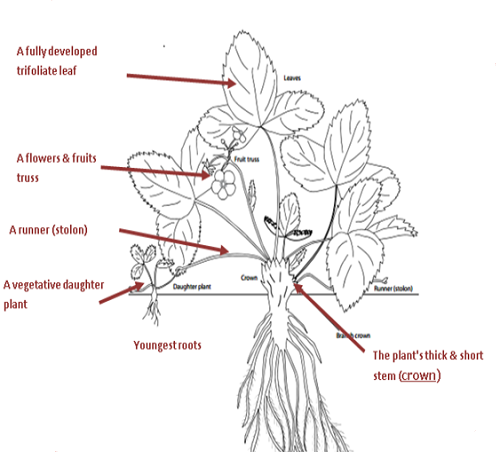
Figure 1.1: Schematic morphology of a strawberry plant
Source: Ellis et al, Ohio, 2006
1.4.1 Root system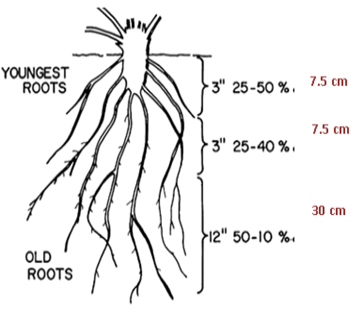

The roots grow following a fixed pattern of three new roots emerging from each side of the base of every new leaf. Generally, there are 20 to 35 primary active roots. The root system is located mainly in the upper 20 cm layer of the soil. The root system is shallow, with 80% to 90% in the top 15 cm (6 inches) of clay. However, in well-drained, sandy loam soils they will be concentrated mainly at the 30 to 40 cm deep layer (see Figure 1.2). A primary root normally lives for one year and is replaced by newer roots as new leaves are formed at successively higher levels on the crown.
Fertility, water supply and aeration at soil depths greater than 15 cm are of major concern. Placing 2 to 3 cm (1 inch) of soil over the plant bed after harvest will enhance new root formation and make plants less vulnerable to cold and drought.
Figure 1.2: Root distribution of a mature strawberry plant, planted in well-drained, light soil
Source: Ellis et al, Ohio, 2006
1.4.2 Shoot system
The petiolate leaves and the inflorescence stalk originate from the short stem that is covered by brownish scales and called the plant's crown. Some axillary buds can develop into branches with long internodes called stolons, which produce a new leaf rosette and adventitious roots at the nodes. The stolons are used for propagation.
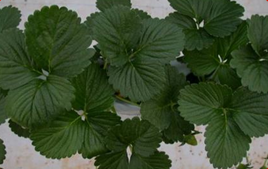
Figure 1.3: Typical strawberry trifoliate leaves
Strawberry leaves are arranged by a fixed spiral phyllotaxis, whereby every fifth leaf is situated exactly above the first one. This arrangement provides the highest light interception. Each year leaves and roots arise at higher points on the crown. Thus, the plant tends to grow out of the ground and develops poor root-soil contact with age. Strawberry leaves are among the richest species in stomata density. The lower surface of the average leaf has 300-400 stomata per square mm. In comparison, apple trees have only about 250 stomata/mm2. This means that on the one hand the strawberry plant can very efficiently absorb atmospheric CO2, but on the other hand, it is very susceptible to arid conditions.
Flowers and fruits are produced on a stalk that emerges from an axillary bud. Each flower is subtended by bracts and has five or more green sepals, five separate white petals, numerous stamens, and a domed receptacle (called a torus) that bears an indefinite number of pistils. In most cases the flowers appear hermaphroditic in structure, but function as either male or female.
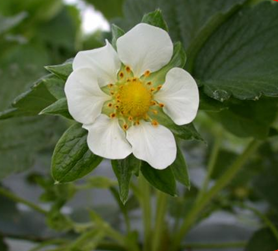
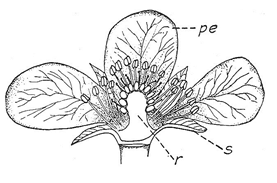
Figure 1.4: A typical strawberry flower Figure 1.5: A strawberry flower
Source: Classic Botany Text, Hill, et al
The flower's pistil (ovary plus style and stigma) develops into a one-seeded, dry fruit, called an achene (see Figure 1.6). The achene is the hard structure found embedded on the fleshy receptacle, which becomes greatly enlarged. Therefore, this edible "fruit" is actually an aggregate fruit, in which the numerous achenes formed within a single flower are borne on a fleshy receptacle of that flower (see Figure 1.7).
Figure 1.6: Close-up photos of strawberry fruits, enhancing the view of the achenes in immature (left) and mature fruits (right)
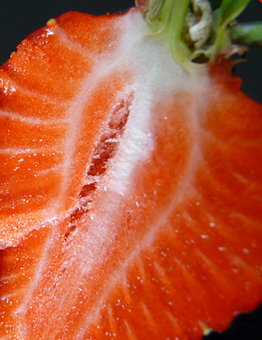
Figure 1.7: Close-up photo of strawberry's thickened receptacle bearing the achenes on its surface
1.5 Fruit types
Depending on the plant’s genetic makeup, the fruits have considerably different shapes and sizes.
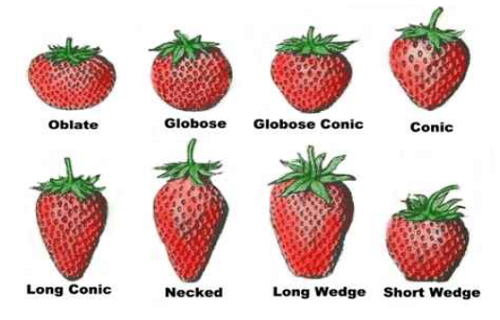
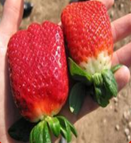
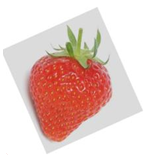
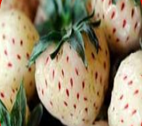
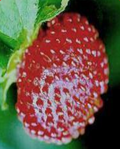
Figure 1.8: Several types of strawberry shapes and sizes
Strawberry fruits are delicate and require gentle handling to prevent bruising. With today's shipping technology, strawberries are available year round, but at a cost. Commercial growers have produced resilient hybrid berries known for their shipping quality.
1.6 Strawberry cultivars
Strawberries come in a wide assortment of commercially available cultivars. Differences between cultivars may include the ability to produce vigorous plants, degree of fertility, disease resistance (mainly to red stele and Verticillium root rots), fruit ripening date, berry freezing quality, firmness, berry size, color, shape, and flavor. Many cultivars have been developed at the University of California (Davis campus) by Driscoll Strawberry Associates Inc. (Watsonville, California), the US Department of Agriculture, Agriculture and Agri-Food Canada, and the UK's East Malling Research Station. Almost all of them are cultivars of Fragaria × ananassa. But some are Fragaria vesca and yet others are Fragaria chiloensis.
Cultivars can be separated into three plant types, based on their response to the number of hours of sunlight per day (photoperiod). These are June-bearers, ever-bearers, and day-neutrals. A relatively updated and exhaustive list of strawberry cultivars is available at https://strawberryplants.org/2010/05/strawberry-varieties/
1.6.1 June-bearing strawberry varieties
Any list of strawberry varieties will probably contain mostly the June-bearing type. June-bearers are tremendously popular and common. They typically produce the largest strawberries, and do so over a period of two to three weeks, on average. Most June-bearing strawberry varieties produce a harvest around the month of June, hence the name. However, June-bearing strawberry varieties are further classified into Early Season, Midseason, and Late Season. By selecting strawberry plant varieties that produce during different parts of the season, one can prolong the harvest time and enjoy fresh strawberries over an extended period.
June-bearing strawberries are most often of the garden strawberry variety, Fragaria x ananassa. They are often planted using the matted row system.
For reference, each of the June-bearing strawberry types generally sets fruit for a total of 10 to 14 days. Early Season strawberry varieties usually begin fruiting in late spring. Early-Midseason strawberry varieties begin fruiting about five days after Early Season varieties. Midseason strawberry varieties begin producing approximately eight days after Early Season varieties. Late-Midseason strawberry varieties begin fruiting about 10 days after Early Season varieties, and Late Season strawberry varieties begin their berry production about 14 days after the Early Season varieties.
The June-bearing strawberry is a short-day plant, i.e., its apices will differentiate into flowers only when days have less than 12 hours of light. It's a popular type for commercial production in places like the Midwest USA, and will produce one crop each year. In the Mediterranean area, short day cultivars are planted in summer or autumn. Flowering occurs in winter and spring; harvest starts in spring.
Figure 1.9: 'Chandler,' fruits, a short-day commercial cultivar grown in California
Following is a short (alphabetical) list of June-bearing strawberry varieties.
Allstar: Berries are large, conical and light red to orange with a mild, sweet flavor. The plants are vigorous and make runners freely. This widely adapted variety has performed consistently well from the East to the central Midwest. It is highly resistant to red stele, with intermediate resistance to Verticillium wilt. It is very popular in Michigan.
Cavendish: Very productive. Large, firm fruit with a good flavor, but with an uneven ripening habit. Plants are moderately vigorous. It is highly resistant to red stele and has some resistance to Verticillium wilt.
Chandler: Introduced by the University of California, this is a standard southern variety grown for wholesale markets in plasticulture. High yields have been experienced throughout the Carolinas and California. Not well suited for regions with harsh winters due to lack of winter hardiness. Chandler is also susceptible to anthracnose disease.
Darselect: (France) is a large fruited, high yielding variety. The berries are attractive and bright red with a long, conical shape. The flavor is very good. However, it tends to be soft. It is susceptible to powdery mildew, which can be a problem in areas with morning fog.
Earliglow: An early berry of high quality. Its fruit is firm with excellent flavor and color. Yields may be low in New England. Fruit size tends to decrease as season progresses. Plants are vigorous runner producers. This is a good variety for beginner growers.It has good resistance to red stele and intermediate resistance to Verticillium wilt.
Elsanta: (Netherlands) is one of the most widely planted varieties in northern Europe. It has a high yield potential and its fruit is firm and aromatic. It is susceptible to red stele, anthracnose, and Verticillium wilt.
Jewel: Aglossy, attractive, medium-sized fruit with a firm texture and flavor. Good production and plants are vigorous with moderate winter hardiness. Care must be taken at renovation, to maintain a good plant stand. It is sensitive to Sinbar and susceptible to leaf spot, red stele, powdery mildew, black root rot, and Verticillium.
Sparkle: The flavor is excellent, but the fruit is dark red and somewhat soft, and fruit size tends to decrease as season progresses. Plants are vigorous and produce many runners. This is one of the heirloom strawberry varieties and is an excellent choice for home gardeners and pick-your-own operations in northern climates.
Wendy: A productive, medium-sized fruit with good flavor and color. Plants are vigorous and produce runners freely. It is moderately resistant to powdery mildew and susceptible to verticillium wilt. Plants do poorly in stressful conditions.
1.6.2 Ever-bearing strawberry varieties
Ever-bearing strawberry varieties are not really “ever-bearing.” They generally produce two harvests per year: one in the spring and another in the late summer or fall. Under ideal conditions, it is possible for some ever-bearing strawberry varieties to produce three berry harvests. Most ever-bearing strawberry types are of the species Fragaria vesca. In general, ever-bearing strawberry varieties put out less runners (or no runners at all) than the June-bearing varieties, as most of the plant’s productive energy is directed toward producing multiple strawberry harvests. Ever-bearing strawberry varieties are often planted using the hill system or in locations where space is limited.
Ever-bearers are long-day plants, i.e., their apices will differentiate into flowers only when days exceed 12 hours of light.
Traditional ever-bearing cultivars such as Ogallala and Ozark Beauty are not truly ever-bearing. They tend to produce a crop in the spring and a small crop in the fall, with little or no crop in between. Ogallala berries are medium sized and dark colored with a fair flavor. Ozark Beauty produces medium-sized, light-colored berries of average quality and has been extremely variable in its performance in Missouri.
1.6.3 Day-neutral strawberries
Day-neutral strawberry plants produce flower buds regardless of the hours of sunlight, approximately three months after planting. They will initiate flower buds during the entire growth season, assuming temperatures do not become too high. Day-neutral cultivars can potentially be harvested about every six weeks. It is generally accepted that day/night temperatures at or above 290C (850F) are the upper limit at which day-neutral strawberries will produce flowers.
The productivity and fruit quality of day-neutral strawberries are much better than the old “ever-bearing” types, such asOzark Beauty, and should be used in place of them. Because of their unique growing habit, day-neutral strawberries must be treated differently than the June-bearing types. Day-neutral strawberries should be grown as annuals, plowed down the spring after planting and replanted every year. Beds can be carried over if plants are healthy and weed-free, but yields from day-neutral strawberries tend to decline dramatically in successive years.
Unlike June-bearing varieties, day-neutral strawberries will produce a good yield in the first year they are planted. They flower and set strawberries whenever the temperature is 20C to 290C (350F to 850F).
During milder years, they will still be producing fruit in October. The drawback to day-neutral strawberry plants is that they produce smaller strawberries than do the June-bearing and ever-bearing strawberry varieties. Their fruit is usually small to medium in size, rarely exceeding 2.5 cm (1 inch). Day-neutral strawberry varieties are often planted using the hill system, or in locations where space is limited.
The best day-neutral strawberry varieties for New England are Seascape, Tribute, and Tristar. Tribute tends to produce more fruit than Tristar, but it also produces more runners, which should be cut off. Both varieties have very good fruit quality.
Thus, day-neutral cultivars such as Tribute and Tristar generally produce a spring and fall crop in most of Missouri. Tributeplants produce moderate to high yields. Berries are large, have excellent firmness and very good flavor. The plants have good winter hardiness, are resistant to red stele and verticillium wilt and tolerant of the leaf diseases. Tristar plants produce moderate yields. Berries are medium to large and have excellent firmness and outstanding flavor.
The Albion strawberry plant (released by the University of California in 2004) is known for its large to very large fruit, which is mostly conical, very firm and red in color. Its flavor is very good for a day-neutral and is sweet and pleasant. It is a high yielding cultivar with robust runners and stalks. It is resistant to verticillium wilt and phytophthora crown rot, and has some resistance to anthracnose crown rot.
The Aromas strawberry plant (released by the University of California) has larger fruit and produces greater yields than Selva or Seascape. Aromas produces large quantities of late-season fruit. It also has a broader environmental tolerance and is more resistant to mildew than Selva, and is especially tolerant to spider mites. Its flavor is very good and fruit size and cull rate are superior to Selva.
Everest (developed in Great Britain) is a fairly new variety that has large, firm, bright red berries. It hardly produces runners and is only suited for plasticulture. Over-wintering can be a problem with this cultivar.
The Hecker strawberry plant (released by the University of California in 1979) has commercial potential for fruit stands and pick-your-own operations due to heavy production. It should perform well everywhere, including Alaska, as it is a day-neutral cultivar. Fruit is medium size with excellent flavor. It is similar to Brighton, but more cold-hardy.
The Monterey strawberry plant (released by the University of California in 2009) is a moderate day-neutral cultivar. It is a vigorous plant, and may require slightly more space than Albion with a similar production pattern. Its fruit is slightly larger than Albion, but less firm. It has an outstanding flavor and a good disease resistance profile, although it is susceptible to powdery mildew.
Portola is a cross between two advanced selections from California. The fruit, produced on long petioles, are orange-red in color and very shiny, almost plastic looking. The berries are larger in size than Albion. Portola is a vigorous plant and may require lower plant density than Albion. The cultivar is slightly resistant to powdery mildew, but is susceptible to leaf blight and botrytis fruit rot. Its yields are earlier and greater than other day-neutral varieties for first-year pickings. However, Portolais neither as flavourful, nor as sweet as Albion. It has a lower percentage of marketable berries, mostly due to botrytis and fruit rots.
The Seascape strawberry plant (released by the University of California in 1991) produces very large, firm fruit, which have a good color and flavor when picked ripe. It is a symmetrical, medium to long conical berry with a glossy finish. It is one of the most popular varieties with a general flexibility in planting dates and areas. Seascape is a very good choice for roadside and farmer’s markets. This variety is highly tolerant of the virus diseases common in California; and is moderately susceptible to leaf rot.
Need more information about growing strawberries? You can always return to the strawberry fertilizer & strawberry crop guide table of contents



